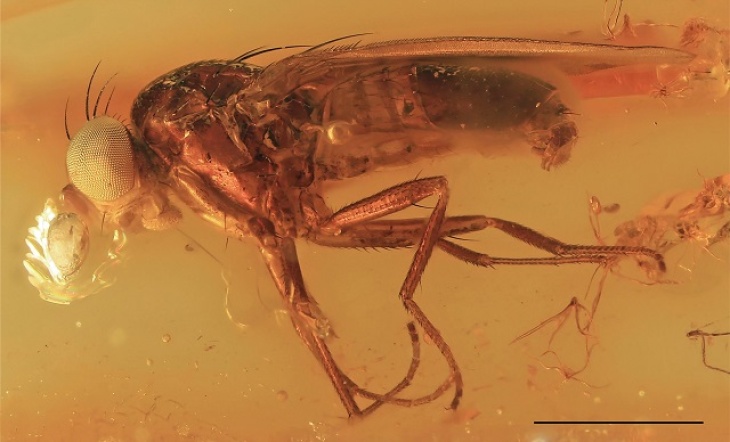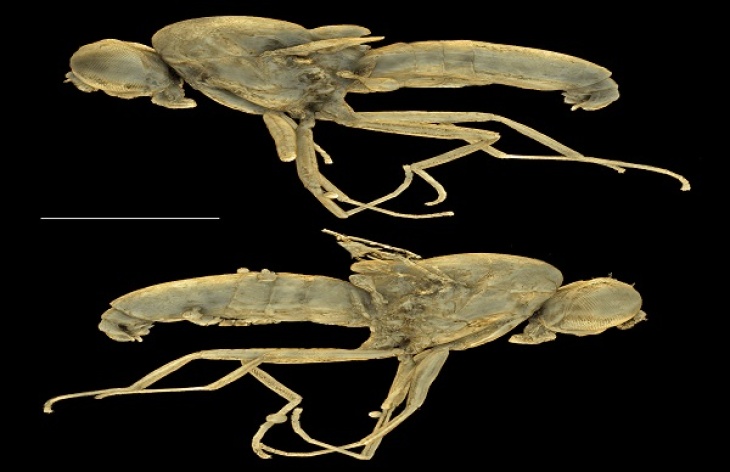Fly in amber
Within the framework of an international study with the participation of the Helmholtz–Zentrum Hereon, an unknown fly was discovered. The extinct genus named Christelenkidae could be described on the basis of the unique specimen named Christelenka multiplex preserved in amber. Despite the enormous diversity of insects, the discovery of a new family is rare and helps to better understand the evolutionary history. The study recently appeared in the journal Arthropod Systematics & Phylogeny.

The new species Christelenka multiplex preserved in amber. Photo: Silesian Museum/ Jindřich Roháček
Until now, this insect was not familiar to anyone. An international research team has described a completely new, previously unknown insect family of the large group Acalyptrata from an amber fossil. This includes important pollinators for ecosystems to this day. The rare find is important for a better understanding of the evolutionary history of this group and its function.
First, the team studied the species in detail under the microscope. Later, it used macrophotography to view the details with better sharpness. However, this was not enough to determine the species. "The amber obscured important features of the specimen preserved in it, which cannot be seen with conventional microscopy," explains Dr Viktor Baranov, author of the study and a researcher at the Estacion Biologica de Donana - Consejo Superior de Investigaciones Cientificas (CSIC).
The team had to resort to state-of-the-art techniques for visualizing fossils, such as synchrotron radiation-based X-ray microtomography of the Hereon. The latter made it possible to create a 3D image of the insect fossil using highly brilliant X-rays. "This technology is similar to computed tomography, which medical professionals use to diagnose diseases. “We can use it to create a three-dimensional image of the studied object on the computer. This digital model can be rotated and cut at will on the computer, so that even hidden features become accessible", says Hereon researcher Dr Jörg Hammel.
Best optical representation

Microtomographic image of Christelenka multiplex. Photo: CSIC/ Viktor Baranov
In the images, the specimen showed a peculiar combination of morphological features - describing the structure and shape of the organisms - with no obvious signs of relationship to any of the other families in the Acalyptrata group. "This meant that this was a family that had never been described before. It is an important discovery, but also an extremely rare one, despite the enormous diversity of insects," Baranov emphasized. The new family was named Christelenkidae - after prominent Hamburg amber collector Christel Hoffeins in recognition of her contribution to paleontological science. The new species became Christelenka multiplex.
The Acalyptrata group is large and diverse, but its fossils are rare, leaving a large gap about its early evolutionary history. "The discovery of this fly will facilitate the study of the entire group and allow us to better understand how it became so important," Baranov concludes. "Such an understanding is especially important given the ongoing biodiversity crisis and the resulting decline in natural pollinators."
Further Information
- Original publication Roháček J, Hammel JU, Baranov V (2023) Christelenkidae, a new extinct family based on a new taxon from Eocene Baltic amber (Diptera: Acalyptratae), with X-ray synchrotron microtomography imaging of its structures. Arthropod Systematics & Phylogeny 81: 475–498.
- Website Consejo Superior de Investigaciones Científicas (CSIC)
- Website Institute of Materials Physics
Contact
Scientist
Phone: +49 (0) 40 8998-5303
Institute of Materials Physics
Helmholtz-Zentrum Hereon
Press Officer
Phone: +49 (0) 4152 87-1648
Communication and Media
Helmholtz-Zentrum Hereon
